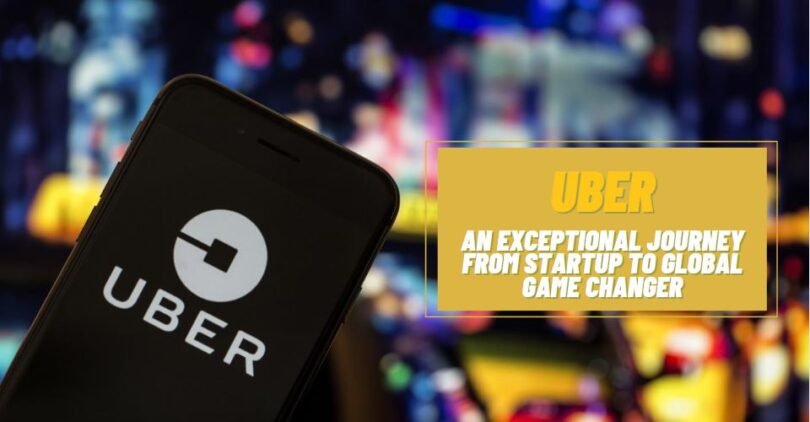Uber is often the first company that comes to mind when considering the online taxi industry. Uber’s focus on quick and easy travel experiences has helped it gain popularity over time. But in many of the markets where it operates, Uber has encountered a number of legal and regulatory issues, such as disagreements regarding worker classification, safety concerns, and many more. Uber retains its popularity and high value despite these difficulties; as of April 2023, its market capitalization exceeded $60 billion. Let’s explore the Uber world in this article, covering its history, business model, revenue model, funding, investments, and other aspects. So, let’s get started.
Uber Company Highlights-
STARTUP NAME – UBER
Headquarters – San Francisco, California
Sector – Transportation
Founder – Garrett Camp, Oscar Salazar and Travis Kalanick
Founded – 2009
Website – uber.com
The Story Of Uber
Uber was founded in 2009 by Travis Kalanick and Garrett Camp, two entrepreneurs from San Francisco, California.
Travis and Garrett each had an odd tale to tell. Both of them left for a conference on a cold Paris evening, but they were unable to locate a shuttle to the location. The two came up with an idea for Uber, a taxi app, as a result of their helpless circumstances.
Finally launching in March 2009, Uber is an on-demand taxi software company with its headquarters located in San Francisco, California. Through the Uber app, users can submit a trip request, which is then forwarded to Uber drivers, who pick up and drop off passengers at their preferred locations using their own vehicles.
Uber’s growth narrative is undeniably remarkable, and their original idea involved utilizing a taxi app to link drivers and passengers. On that day, Camp began developing their mobile application prototype. Camp had the idea to start working on an Uber cab prototype by March 2009. Later, as a Chief Incubator, Kalanick joined UberCab. He was hired to oversee Uber following its San Francisco launch. Then, using just three cars, Camp, Kalanick, and Oscar Salazar tested their service in January 2010. Ryan Graves relocated to San Francisco in March 2010 to take a position as general manager at Uber, having previously worked in Chicago.
In July 2010, Uber went live for the general public, and in August of the same year, Graves was named CEO of the company. Afterwards, Graves became COO in December 2010, and Kalanick became CEO.
Funding Of Uber
Uber’s founders, Travis Kalanick and Garrett Camp, raised $200k in the company’s very first seed funding round in 2009.
Uber secured a $1.25 million seed funding investment in October 2010 from First Round Capital, Kalanick’s friend Chris Saca, and Napster co-founder Shawn Fanning.
Uber contracted a $11 million Series A funding round in February 2011, valuing the company at $60 million. Bill Curley has joined Uber’s Board of Directors.
In December 2011, Uber started its international expansion and secured a $32 million Series B funding round led by Jeff Bezos of Amazon, Goldman Sachs, and Menlo Ventures.
At a $3.76 billion valuation, Uber received a substantial $258 million investment from Google Ventures as part of its series C funding round, which was completed in August 2013.
In July 2014, Uber expanded into China and secured $1.2 billion in series D funding, at a valuation of $17 billion.
Uber received $600 million in funding from Chinese search powerhouse Baidu in December 2014. Uber started to be integrated with Baidu’s mobile search and maps apps.
In September 2015, Uber’s China arm raised $1.2 billion to help it compete in the China market.
Didi Kuaidi, Uber’s main competitor, responded by putting in roughly $3 billion in investments.
In January 2016, Uber secured a further $2 billion in private equity to continue funding its plans for international expansion.
In February 2016, Russian billionaire Mikhail Fridman invested $200 million in Uber.
In June 2016, Uber raised an additional $3.5 billion from the Saudi Arabia Public Investment Fund, its largest investment from one investor. Uber’s board was joined by Yasir Al Rumayyan, managing director of the Public Investment Fund.
In July 2016, the company received another $1.15 billion cash infusion, but this time in the form of a leveraged loan.
In December 2017, Uber raised an additional $7.7 billion, with SoftBank leading the fundraising at a $40.3 billion valuation.
In May 2018, Uber fund raised $600 million, with a $56 billion valuation.
Uber’s Investment
In total, Uber has made 24 investments. Take a look at a few of Uber’s investments:
Business Model Of Uber
With its transparent and creative business model, Uber has completely changed the transportation industry. Uber operates as a middleman via a digital platform, connecting customers seeking for taxi services with independent drivers who drive their own vehicles. Through specialized apps, Uber connects drivers and riders, using an algorithm to do so. In particular, Uber does not own any cars; instead, it operates on a commission-based business model, charging an average of 15% to 30% commission from each booking.
The key components of Uber’s business model are Uber employs “surge pricing,” a dynamic pricing strategy that modifies ride prices in response to supply and demand. Prices rise at peak periods when demand for rides is greatest in order to encourage more drivers to get on the road. Via its mobile app, Uber’s platform connects drivers and riders. Users can use the app to request rides, track their driver, and make cashless payments. Uber’s business model heavily relies on its network of drivers. Upon sign up on the platform, drivers can begin receiving payment for their rides. To maintain drivers’ motivation and engagement, the company also provides bonuses and incentives. Uber prioritizes the user experience, offering riders a simple and convenient mode of transportation. To enhance its service and customize the user experience, the company leverages analytics and data. Uber has diversified its services beyond its initial ride-hailing service and has quickly entered new markets. In addition to investing in other forms of transportation like electric bikes and scooters, the company currently provides food delivery services through Uber Eats. Uber expands its offerings and enhances the user experience by partnering with different businesses.
Revenue Model Of Uber
The company’s revenue model is commission-based, meaning that for each trip made via its platform, it keeps a portion of the total fare that the rider is charged. Among its revenue models are the following:
Rides Commission: Commissions from each ride are Uber’s primary revenue stream, as previously stated. Depending on the location, the company’s commission percentage can be anywhere between 20 and 30 percent of the total fare that the rider is required to pay.
Surge Price: Uber may use surge pricing, which raises the fare that riders must pay, during times of high demand. In order to guarantee that riders can get a ride when they’re in need of it, this surge pricing encourages more drivers to get on the road. Surge pricing also allows Uber to make a higher commission during peak demand periods.
Fees: Cancellation fees are an additional source of revenue for Uber. Riders are assessed a cancellation fee, which is determined by the ride fare, if they decide to cancel their rides after a specific time. Uber receives this money directly.
Uber Eats’ on-demand food delivery service is another important source of revenue for the company. There is a delivery fee associated with each order that is placed. This amount is computed using a number of bases, including area, distance, and the demand at that particular time. About 25% of the delivery fee is charged by the app. Uber thus benefits money from each order that is placed.
Advertising And Promotion: To display adverts, promotions, or sponsored content inside its app, Uber partners with companies and brands. These ads could be for restaurants on UberEats, sponsored initiatives for the highly engaged and focused audience of Uber app users, or discounts for businesses that pay Uber to place and display their advertisements so they can access a specific location. The money from advertising boosts Uber’s overall revenue and helps pay for operating costs.
Challenges Faced By Uber
Similar to other businesses, Uber encounters various challenges that may have an impact on its functioning, financial outcomes, and general success. These are a few of the major challenges that Uber is dealing with:
Regulatory obstacles: Regulatory challenges have been one of Uber’s most significant challenges in recent years. Many cities and nations’ governments and regulators have gone after the company, claiming that its business model does not comply with current laws and regulations. As a result, the company’s operations are now prohibited or restricted in some places.
Legal Challenges: Legal battles are resulting from drivers suing Uber to be categorized as employees instead of independent contractors. Lawsuits about matters of safety, like allegations of insufficient safeguards against harassment and assault, add to the complexity of the legal system.
Safety concerns: Both the drivers and riders, Uber’ major concern is safety. In response to criticism that it is not doing enough to safeguard drivers and passengers, the company has changed a number of its policies and practices.
Financial Difficulties: Uber faces financial difficulties despite its high valuation. Investor demands for sustained profitability have resulted in strategic changes to its cost structure and business strategy.
The impact of COVID-19: Due to lockdowns and travel restrictions, the COVID-19 outbreak has had a major impact on Uber’s ride-hailing company. Concerns about the safety of drivers and riders have intensified, which presents another challenge for the company.
Uber Controversies
A number of controversies have affected Uber, and as a direct result, several longtime executives have left the company. First, there are the protracted legal battles that Uber has fought in major cities like New York and San Francisco, where it has primarily lined up against large taxi interests that saw Uber as a serious threat.
Uber received a “cease and desist” letter from the Metro Transit Authority of San Francisco in 2010, accusing the company of operating a taxi service without the required license. Uber was granted permission to continue operating on San Francisco’s streets in 2013 after three years of regulatory wrangling.
In 2013, 35,000 company drivers filed a class-action lawsuit against Uber, claiming that their status as independent contractors was unfair. The drivers wanted full-time employment, with the higher pay and benefits that come with being an employee.
Uber and its drivers reached an out-of-court settlement, and Uber drivers are still considered contractors in most U.S. states, despite efforts by the company to increase pay and job perks.
Uber faced further controversy in 2014 when its then-CEO, Travis Kalanick, came under scrutiny for referring to his own company as “Boober” during an interview with GQ magazine about the ride-sharing company’s appeal to female consumers. After Susan Fowler, a former staffer of Uber, wrote a blog post criticizing the company’s toxic and sexist workplace culture, the issue gained significant attention.
Following Holder’s report, which supported Fowler’s assessment of the company, 20 employees of the company resigned, and new rules regarding behavior by staff in the workplace were implemented.
Uber’s Growth
Uber has hit several significant growth benchmarks, including by 2023, Uber would be present in over 10,000 cities worldwide, by 2023, it has access to rides at more than 700 airports, by 2023, the global count of Uber drivers is 5.4 million, when December 2023 rolls around, 23 million Uber trips have already been made, in 2018, Uber was valued at $72 billion; by 2023, that amount is expected to have increased to about $130 billion, by July 2018, it had made 10 billion journeys across the globe, Uber’s stock has performed exceptionally well on the NYSE since going public on May 9th, 2019.






